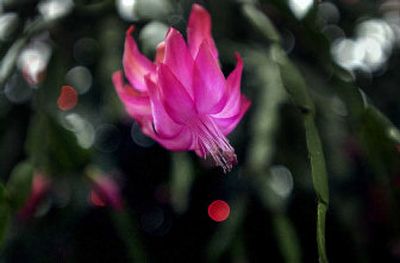Manito’s Christmas cactus is turning 100

There is a birthday celebration going on this year at Manito Park’s Gaiser Conservatory. The matriarch of the greenhouse – the enormous Christmas cactus that holds court at the back of the entry room – is turning 100 years old.
According to Stephanie O’Byrne, the greenhouse manager, it was propagated in 1906 and then donated to the greenhouse several decades ago. Today it has a spread of at least 6 feet and each of its branch tips has a pink bud that should be open now.
The Christmas cactus is only one of the thousands of plants and lights O’Byrne and her crew are getting ready for this year’s Holiday Lights celebration at the conservatory. With all these plants, O’Byrne has learned a thing or two about caring for holiday houseplants. The first thing is that you don’t have to be an expert to make blooming plants part of your holiday tradition.
Christmas cactus
The Christmas cactus loves a bright, indirectly lighted place near a window during the cooler months and a shady spot in the garden over the summer. Let it dry out a bit between waterings and feed it with a balanced fertilizer in the spring. O’Byrne hasn’t repotted the Manito plant in the 22 years she has been at the greenhouse. “They bloom better if they are pot-bound.”
To get a Christmas cactus to bloom, it needs to be put in a cool room – 50 to 60 degrees – by late October with plenty of bright light during the day and about 12 hours of total darkness at night. Buds begin forming on the branch tips around the end of November and open during mid December.
Poinsettias
Poinsettias have been a part of our Christmas tradition since the early 1900s. The brightly colored parts of the plant are actually modified leaves called bracts. The poinsettia flower is the golden yellow clusters found in the center of the colored bracts. Modern poinsettias now come in dozens of shades of red, white, pink, burgundy and variegated blends making them a very versatile holiday decoration.
For best results, place plants in a cool room where they get six or more hours of bright indirect light. Water thoroughly when soil is dry to the touch, but don’t let the plants sit in water. Place plants where they won’t be exposed to cold or hot drafts.
“The biggest problem people will have is overwatering them,” says O’Byrne. “Putting it by an outside door that gets opened regularly is a no-no.”
Amaryllis
O’Byrne saves her amaryllis show for early January. “It gives us some color to look forward to after the holiday.”
Amaryllis bulbs are relatively easy to force into bloom. If you get a pre-planted bulb, simply place it in a bright but indirectly lighted spot and water it thoroughly to let the plant know it’s time to break dormancy.
Loose bulbs should be planted with the top third exposed in 6- to 8-inch inch pots. Group bulbs in a 10- to 12-inch flat-bottomed container, as they tend to be top heavy when in bloom. Leave a half-inch space between the soil and the top of the pot to accommodate water. Insert a stake in the pot to help keep the top heavy bloom upright.
Place bulbs in a warm place (70 degrees) that gets bright, indirect light. Water sparingly until growth starts, then more frequently after the bulb begins growing. Turn the pot a quarter turn a couple of times a week to keep the plant growing straight. Flower buds should appear within a few weeks.